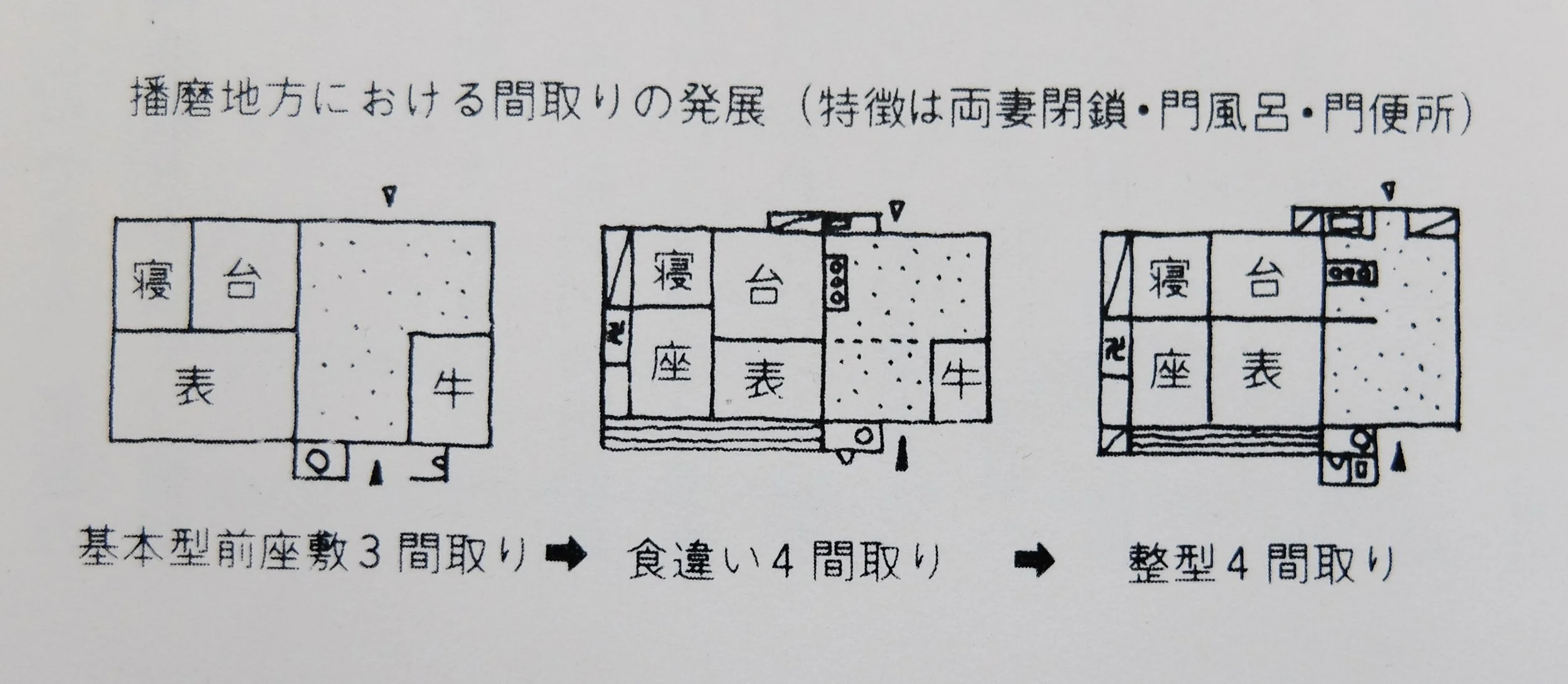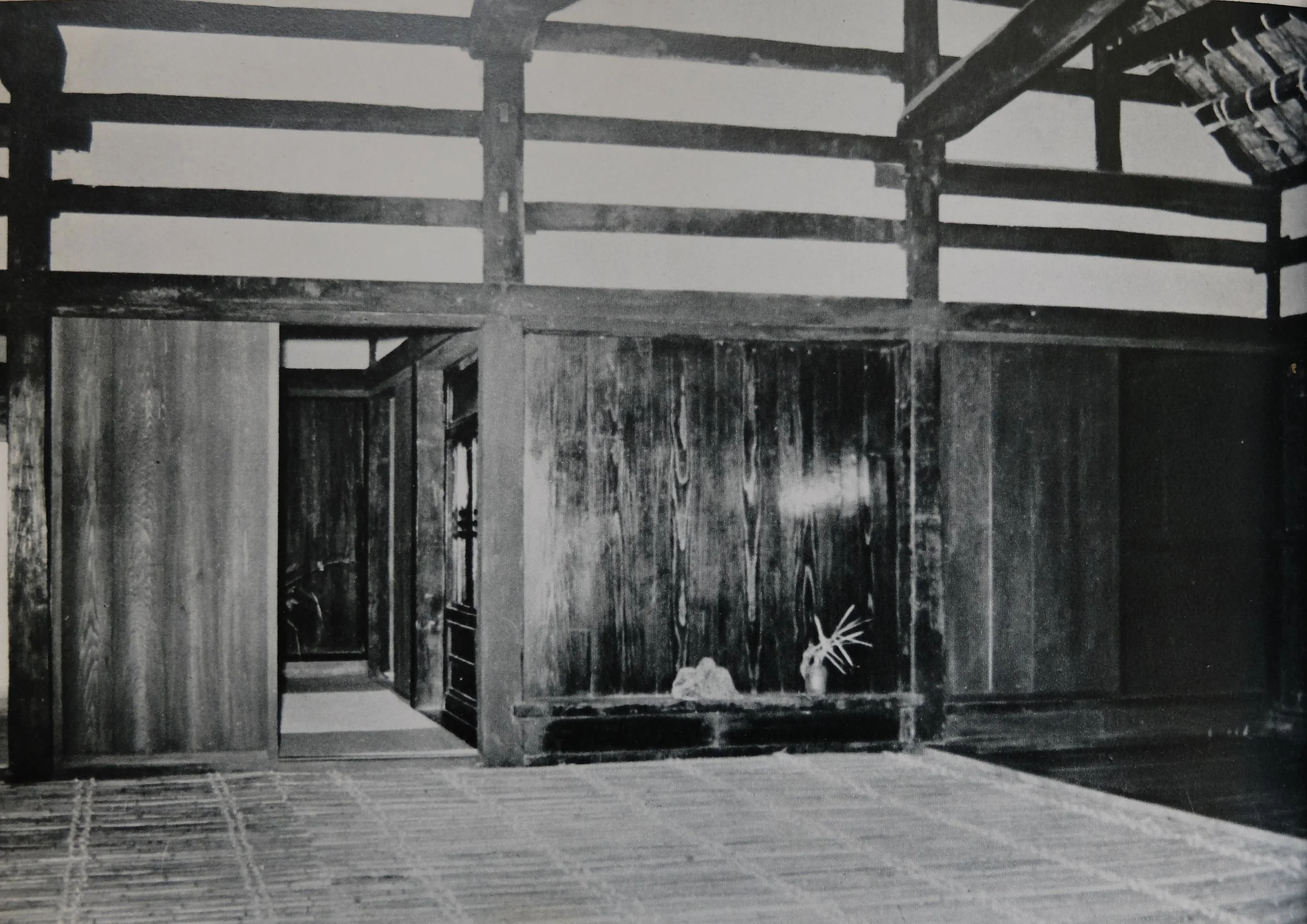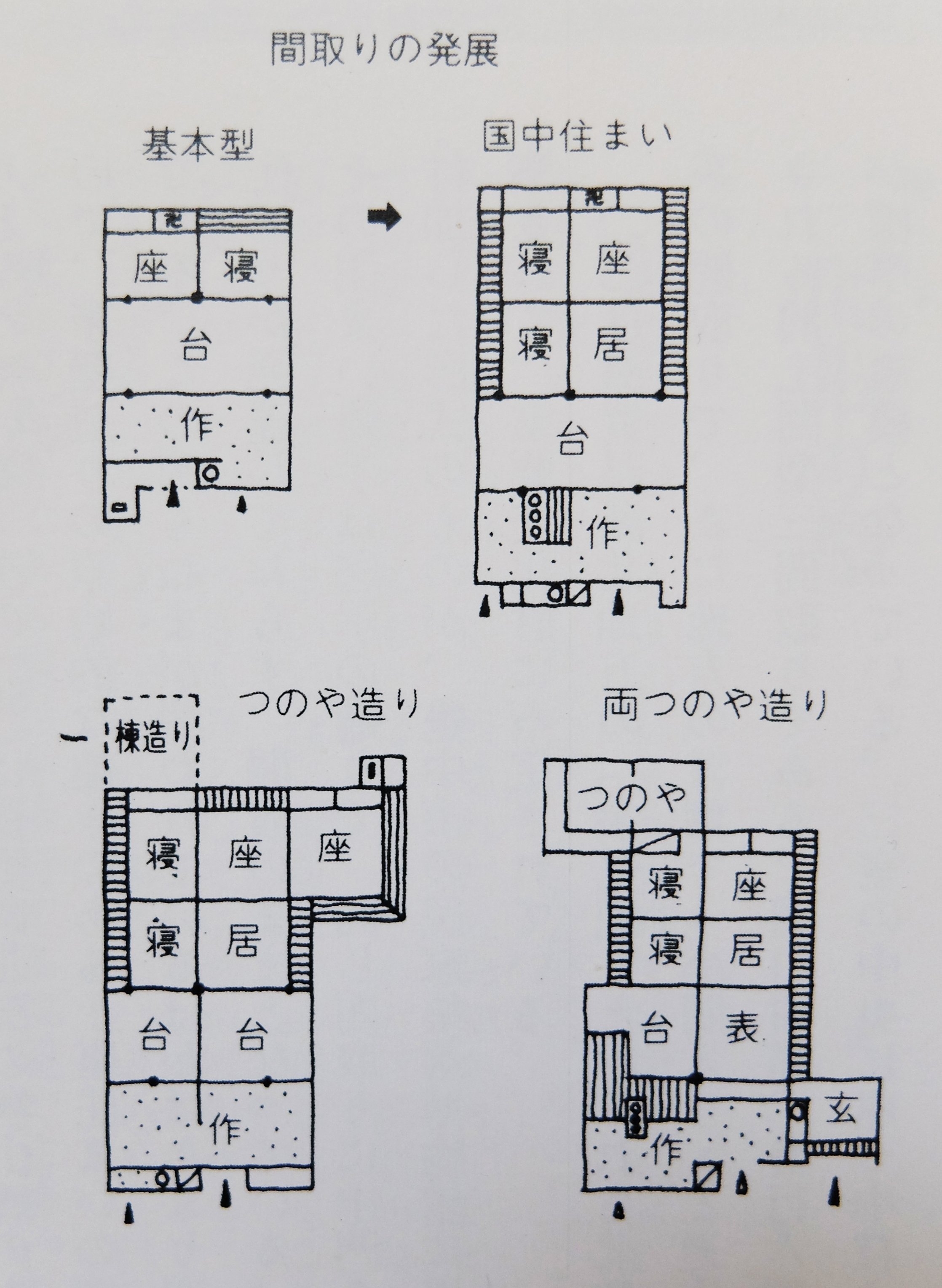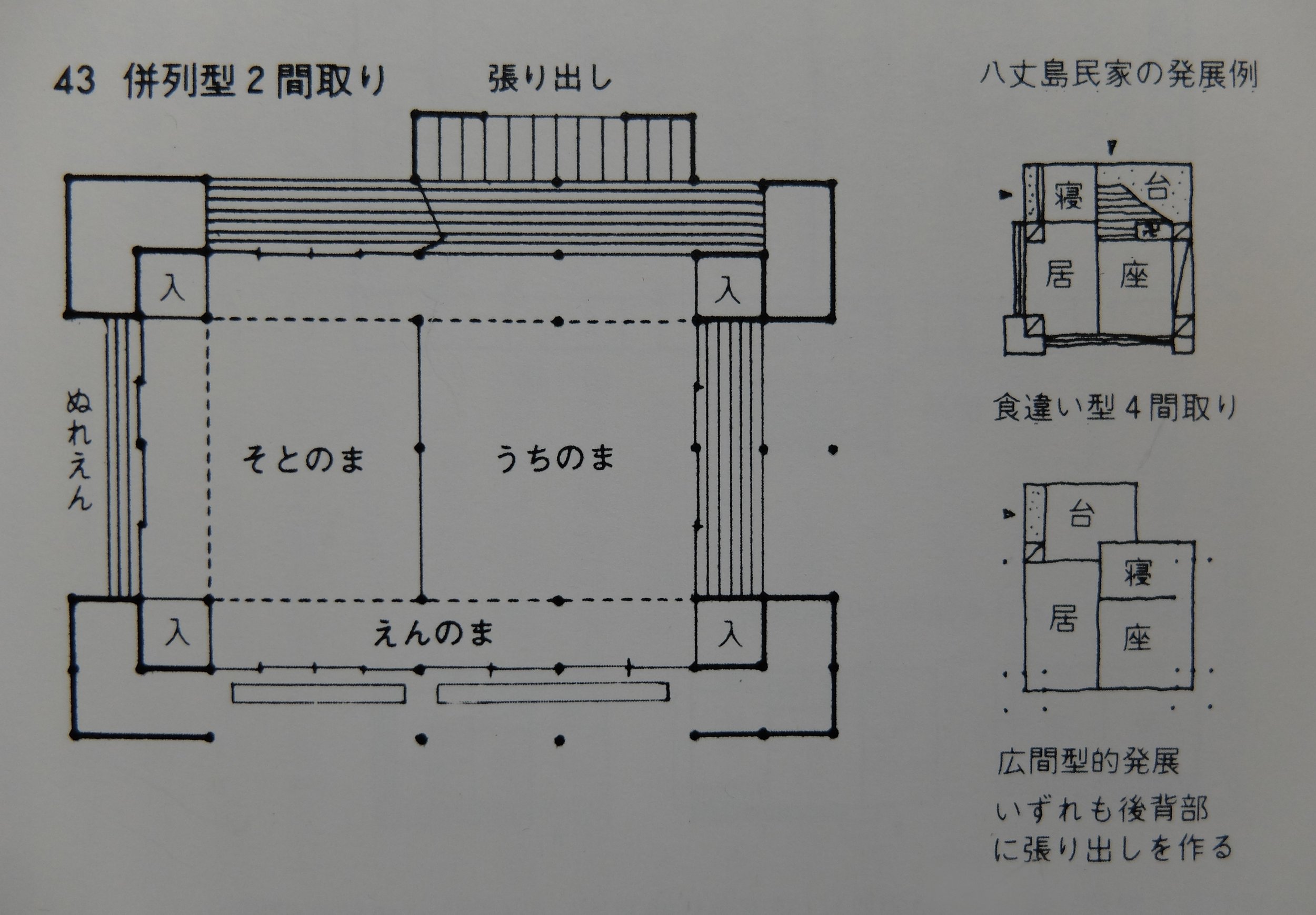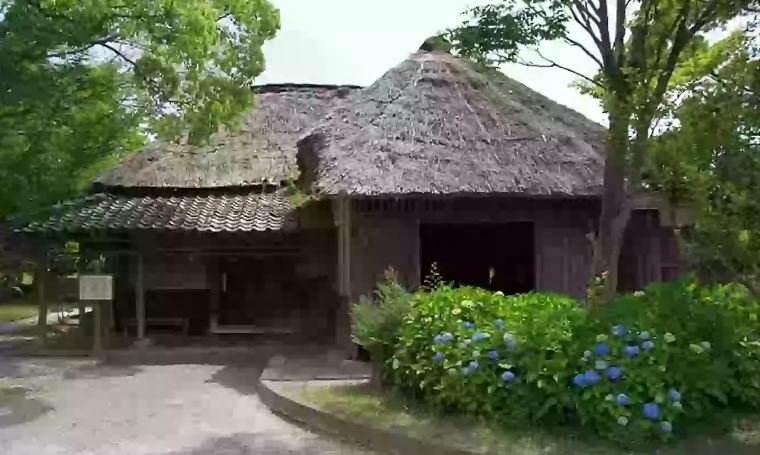Continuing with our discussion of four-room minka layouts, in this post we will take a look at how four-room layouts evolved over time by comparing some older and newer examples.
The plan below, of the Yamamoto house (Yamamoto-ke 山本家) in Osaka Prefecture, is an example of an old-fashioned four-room layout, with a relatively ‘closed’ character. The bedroom (nando なんど) in particular is completely isolated from the rest of the interior, and there is a step-in type closet in the entry doma. At the time of survey, there was a decorative alcove (tokonoma 床の間 or toko 床) in the gable wall of the zashiki, a style known as tsuma-doko (妻床, lit. ‘gable toko’), but originally the Buddhist alcove (butsuma 仏間) and the shelves (todana 戸棚) at the boundary with the nando would have been the only decorative elements of the zashiki, in the absence of a tokonoma; this style is called hira-toko (平床, lit. ‘flat toko’).
The Yamamoto house. Labelled are: the earth-floored utility area, consisting of the niwa (にわ), with entry doma (iriguchi doma 入口土間) and menses (seiri 生理) closet, and for agricultural work (nо̄-sagyо̄ 濃作業) and feed preparation (shiryо̄ chо̄sei 飼料調整); the stable (umaya うまや) for raising livestock (kachiku shi-iku 家畜飼育) and composting (taihizо̄sei 堆肥造成); the ‘stove doma' (kamaya かまや), with stove (kudo くど), sink (hashiri はしり), ‘lever thresher' (kara-usu カラウス) and smoke bulkhead (kemuri-kaeshi 煙返し), for food storage (shokuryо̄ chozо̄ 食糧貯蔵), meal preparation (tabemono chо̄sei 食物調整), and food preparation (shokuryо̄ chо̄sei 食糧調整); a board ‘landing' (toko とこ) for lunch (chūshoku 昼食) and handwork (te-shigoto 手仕事); the kitchen-dining room (daidoko だいどこ) for dining (shokuji 食事), family time (danran 団らん), and evening or night work (yonabe-shigoto よなべ仕事) with shelves (todana 戸棚) and bedroom entry (nando-gamae なんど構え); the bedroom (nando なんど) for sleeping (shūshin 就寝) and storage of family possessions (kazai shūnо̄ 家財収納; the zashiki (ざしき), for ceremonies (gyо̄ji 行事), receiving guests (sekkyaku 接客), and sleeping (shūshin 就寝), with Buddhist alcove (butsuma, marked manji 卍) and shelves; and the ‘second room' (tsugi-no-ma 次の間), here kuchi-no-ma (くちのま), for entertaining (о̄tai 応対), courting (kо̄sai 交際), and as a ‘breakout room' for the ceremonies of the oku-no-ma. The ‘verandah' (en えん) is also used for handwork and entertaining. There is an outside urinal (shо̄ben 小便, marked 小) next to the entrance. The position of the current (genjо̄ 現状), non-original gable-wall decorative alcove (tsuma-toko 妻床) is indicated with dashed lines.
Interior view of the zashiki of the Yamanoto house, looking towards the Buddhist alcove (butsuma 仏間) on the right and shelves (todana 戸棚) on the left. Leaning against the shelves is a low table known as a kotatsu, with an electric heating element visible on its underside.
A ‘lever thresher' (kara-usu 唐臼 or カラウス, lit. ‘Chinese mortar') for threshing grain.
The next plan, of the Nakashima house (Nakashima-ke 中島家) in the Iga district (Iga chihou 伊賀地方) of Mie Prefecture, is a representative example of what eventually became the most widely-distributed style of regular four-room layout. This (comparatively) new type is characterised by an interior that is relatively open, meaning that the boundaries between all four rooms are fitted with sliding, unfixed partitions; if these partitions are removed, a single, continuous space is obtained. This open character extends to the nando, which is no longer the dark ‘bedcloset’ of the Yamamoto house. Its private nature has been reduced and it has taken on some of the functions of a living room, necessitating the addition of a closet to store (hide) bedding during the day. The butsuma and storage are now out of the way in the gable wall, making this a true tsuma-doko layout.
Other than the blind gable wall to the nando and okunoma, the rooms are also very open to the outside, and the exterior walls of the dwelling are highly permeable: of the 43 total intra-post ‘bays’ (each around half a ken or 91cm wide) that make up the exterior walls, only 25 are solid wall; the other 18 are occupied either by sliding partitions or by windows of some description. Even the niwa has an entrance on all three of its sides.
At the border of the denoma (でのま) and the okunoma (おくのま) there are obito (帯戸), wooden panel sliding partitions (itado 板戸) with a mid-rail (obizan 帯桟), which give greater formality to the zashiki; in the feudal (hо̄ken 封建) period the obito signified that women, children, and people of low status were not to enter this room without good reason.
The Nakashima house. Labelled are: the earth-floored utility area, consisting of the niwa (にわ), with entry doma (iriguchi doma 入口土間), and bath (furo ふろ), for agricultural work (nо̄-sagyо̄ 濃作業); the stable (maya まや) for raising livestock (kachiku shi-iku 家畜飼育) and composting (taihizо̄sei 堆肥造成); the ‘stove doma' (kamaya かまや), with stove (kudo くど), lever mortar (kara-usu カラウス) and smoke bulkhead (kemuri-kaeshi 煙返し), for food preparation (tabemono chо̄sei 食物調整), food storage (shokuryо̄ chozо̄ 食糧貯蔵), and feed preparation (shiryо̄ chо̄sei 飼料調整); and the ‘inner niwa' (uchi-niwa うちにわ), with sink (nagashi ナガシ) and board ‘landing' (ochima おちま), for meal preparation (tabemono chо̄sei 食物調整); the kitchen-dining room (daidoko だいどこ) for dining (shokuji 食事), family time (danran 団らん) and handwork (te-shigoto 手仕事), with shelves (todana 戸棚); the bedroom (nando なんど) for sleeping (shūshin 就寝) and storage of family possessions (kazai shūnо̄ 家財収納), with closet (oshi-ire 押入); the zashiki, here oku-no-ma (おくのま), for ceremonies (gyо̄ji 行事), receiving guests (sekkyaku 接客), and sleeping (shūshin 就寝), with Buddhist alcove (butsuma, marked manji 卍) and storage; and the ‘second room' (tsugi-no-ma 次の間), here de-no-ma (でのま), for entertaining (о̄tai 応対), and as a ‘breakout room' for the ceremonies of the oku-no-ma. The ‘verandah' (en えん) is also used for handwork and entertaining, and accessing the urinal (shо̄ben 小便, marked 小). Partitions are marked ko (コ) for kо̄shi (lattice), sasara-do (ササラ戸, very fine, closely-spaced lattice), shi (シ) for shо̄ji (障子, lattice with thin transparent paper on one side), fu (フ) for fusuma (襖, lattice with thick opaque paper on both sides), and obito (オビト).
Four obito (帯戸)


















